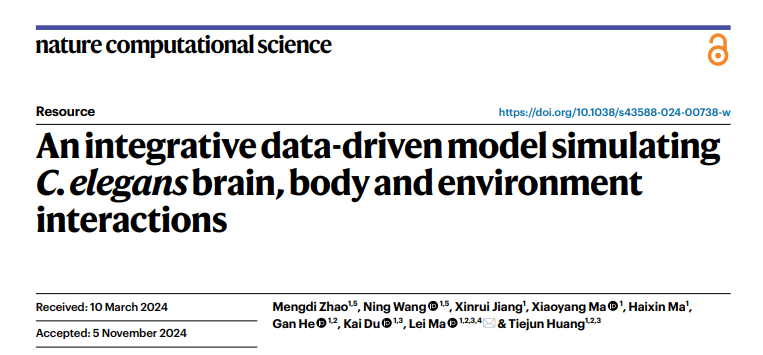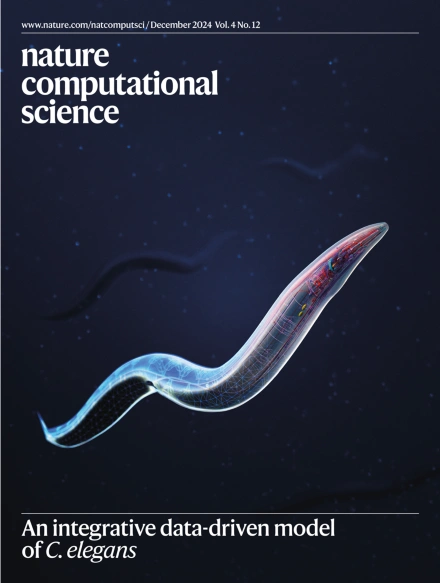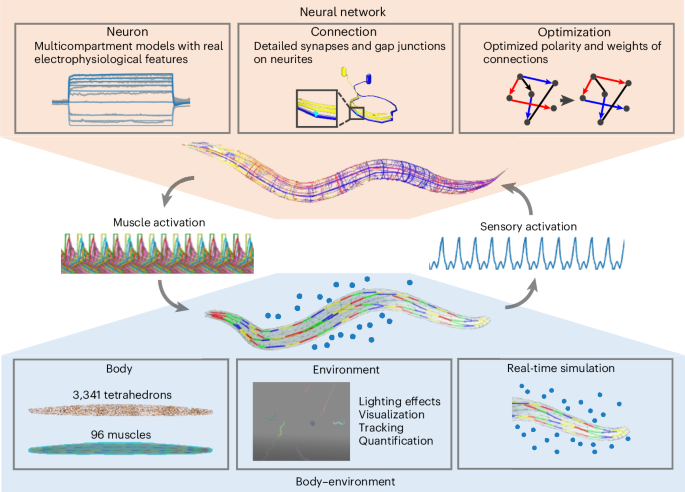Nature Computational Science | Lei Ma's Team Develops a Data-Driven Integrative Model of C. elegans
Source: Professor Lei Ma's Research Team

On December 16, 2024, Dr. Lei Ma, Associate Research Professor at the National Biomedical Imaging Center published a paper titled “An integrative data-driven model simulating C. elegans brain, body and environment interactions” in Nature Computational Science. This paper was featured as the journal's cover story on December 21, 2024.
Article link (Open Access): https://www.nature.com/articles/s43588-024-00738-w
Research Briefing link: https://www.nature.com/articles/s43588-024-00740-2
BAAIWorm GitHub Repository: https://github.com/Jessie940611/BAAIWorm

Overview
Lei Ma and his colleagues created an open-source model that simulates Caenorhabditis elegans (C. elegans) in a closed-loop system by integrating simulations of its brain, physical body, and environment. This model replicates C. elegans' locomotive behaviors, and synthetic perturbations of synaptic connections impact the neural control of movement and affect embodied motor behavior.
The mission
In Caenorhabditis elegans, behaviors such as movement and foraging are driven by a coordinated, closed-loop interaction between its neural circuitry, muscular biomechanics, and real-time environmental feedback. Traditional models often isolate neural1 or physical components, missing the holistic brain–body–environment interactions that underpin complex behaviors2. Capturing this complexity in a biophysically detailed simulation remains challenging3, which highlights the need for fully integrative, closed-loop models that bridge neural networks, biomechanics and environmental feedback.
Lei Ma‘s team’ uses a scalable, multi-level approach that includes a multi-compartmental neural modelling methodology, where gap junctions, synapses and neurons are simulated in intricate detail within entire neural networks to produce biophysically accurate neural dynamics. In this study, his team set out to develop an open-source model, that simulates an embodied C. elegans in a closed-loop system.
The solution
The team developed BAAIWorm (a brain–body–environment model) as an open-source modular system to provide a versatile platform for investigating fundamental mechanisms of neural control in embodied behavior. This model consists of two sub-models based on experimental data: a biophysically detailed neural network simulating the entire 302-neuron C. elegans neural system, and a lifelike model of its physical body surrounded by a 3D environment (Fig. 1). Each neuron in the network is represented as a multi-compartment model, simulating structural and functional neuron segments (dendrites, soma, axons) to accurately replicate C. elegans's electrophysiological properties, including detailed synapse and gap junction functions based on experimental data (Fig. 1, top left). The body model incorporates 96 muscle actuators (based on C. elegans anatomy but modeled in four 24-cell quadrants for computational symmetry) within a 3D fluid environment, where surface-level forces simulate thrust and drag, optimizing computational efficiency while reflecting life-like fluid–body interactions. Continuous sensory inputs from the environment (a food concentration gradient) dynamically influence neural computations, which in turn drive muscle contractions, creating a closed-loop feedback system that aligns model’s behavior with environmental cues (Fig. 1).

Fig. 1: BAAIWorm is an embodied Caenorhabditis elegans simulation.
BAAIWorm integrates a biophysically detailed neural network model with a biomechanical body and 3D environment in a closed loop system of sensory stimulation and muscle activation. The neural network connects neurons via biologically detailed synapses and gap junctions on neurites, optimized for realistic neural dynamics by iteratively adjusting model parameters (such as connection weights, synaptic delay) to match observed electrophysiological properties in C. elegans. The body model, composed of 3,341 tetrahedrons (as the basic modeling element for the body structure) and 96 muscles, interacts with the 3D environment for real-time locomotion simulation. © 2024, Zhao, M. et al., CC BY-NC-ND 4.0.
The future work
This model currently includes simplified sensory inputs and essential model simplifications. Future enhancements are needed to accurately simulate more complex sensory responses and behaviors to expand its utility across more diverse experimental contexts. In its simulation of C. elegans’s well-mapped neural network and well-defined behaviors, BAAIWorm achieved biological plausibility within a closed-loop system to meet the challenge of ‘whole’ organism simulation.
As an early project of the Digital Life Initiative, Lei Ma and his team will incorporate additional C. elegans connectome and behavioral data based on this data-driven approach.
Expert opinion
“This manuscript describes an impressive body of work to consolidate information on the physiology and anatomy of C. elegans into a computational model that links neuronal activity and interactions with the body and environment. Several advancements are presented at different scales, and the various developments fit together into a coherent picture. It complements other initiatives in the community to database experimental knowledge related to C. elegans and create data-driven simulations of the worm”. Padraig Gleeson, University College London, London, UK.
From the editor
“This work from Lei Ma and colleagues stood out to me because they develop an integrative model of C. elegans that combines the detailed simulation of neural networks with a biophysically realistic body and environmental interactions. The interplay of dynamic body–environment interactions and intricate simulations makes it possible to investigate how brain activity affects behavior in a closed-loop system.” Ananya Rastogi, Senior Editor, Nature Computational Science.
References
Lobato-Rios, V. et al. NeuroMechFly, a neuromechanical model of adult Drosophila melanogaster. Nat. Methods 19, 620–627 (2022).
Sarma, G. P. et al. OpenWorm: overview and recent advances in integrative biological simulation of Caenorhabditis elegans. Phil. Trans. R. Soc. B 373, 20170382 (2018).
Zhang, Y. et al. A GPU-based computational framework that bridges neuron simulation and artificial intelligence. Nat. Commun. 14, 5798 (2023).
Beniaguev, D. et al. Single cortical neurons as deep artificial neural networks. Neuron 109, 2727–2739 (2021).
Zador, A. et al. Catalyzing next-generation artificial intelligence through NeuroAI. Nat. Commun. 14, 1597 (2023).




